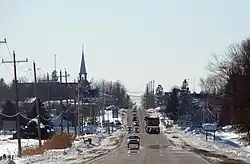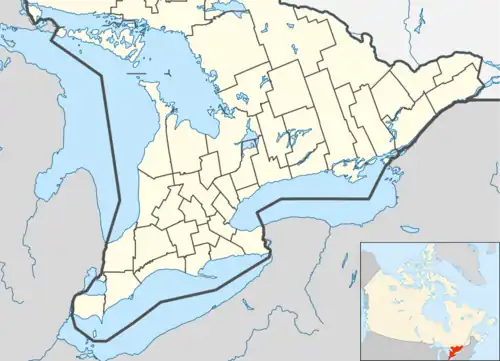Alfred and Plantagenet | |
|---|---|
| Township of Alfred and Plantagenet Canton d'Alfred et Plantagenet | |
 | |
 Alfred and Plantagenet  Alfred and Plantagenet | |
| Coordinates: 45°34′N 74°55′W / 45.567°N 74.917°W | |
| Country | Canada |
| Provinces | Ontario |
| County | Prescott and Russell |
| Formed | January 1, 1997 |
| Government | |
| • Mayor | Stéphane Sarrazin |
| • Federal riding | Glengarry—Prescott—Russell |
| • Prov. riding | Glengarry—Prescott—Russell |
| Area | |
| • Land | 392.31 km2 (151.47 sq mi) |
| Population (2016)[1] | |
| • Total | 9,680 |
| • Density | 24.7/km2 (64/sq mi) |
| Time zone | UTC-5 (EST) |
| • Summer (DST) | UTC-4 (EDT) |
| Postal Code FSA | K0B |
| Area codes | 613, 343, 753 |
| Website | www |
Alfred and Plantagenet is a Franco-Ontarian township in eastern Ontario, Canada, in the United Counties of Prescott and Russell. Located approximately 70 km (43 mi) from downtown Ottawa at the confluence of the Ottawa River and the South Nation River.
The township was formed on January 1, 1997, through the amalgamation of Alfred Township, Alfred Village, North Plantagenet Township, and Plantagenet Village.
Plantagenet is from the royal house established by King Henry II. Settled in 1811-12. Post office from 1838.[2]
Near the town of Alfred, the Ontario Ministry of Natural Resources has designated the Alfred Bog as "a provincially significant wetland and an Area of Natural and Scientific Interest." Species of interest include the palm warbler, northern pitcher-plant, pink lady's-slipper, cottongrass, bog elfin and bog copper butterflies, and ebony boghaunter dragonfly. It also hosts one of the most southerly herds of moose. The bog is open to the public with a 272-metre (892 ft) boardwalk for nature walks.[3]
University of Guelph-Ontario Agricultural College's Alfred College was located here until 2015.
Communities
The township comprises the communities of Alfred, Alfred Station, Blue Corners, Centrefield, Coin Gratton, Curran, Glenburn, Jessups Falls, Lefaivre, Pendleton, Plantagenet, Plantagenet Station, Rockdale, Senecal, The Rollway, Treadwell, Wendover, and Westminster. The township administrative offices are located in Plantagenet.
 Main street in Alfred
Main street in Alfred Skyline of Plantagenet
Skyline of Plantagenet Wendover
Wendover The Alfred Bog trail sign
The Alfred Bog trail sign
Demographics
In the 2021 Census of Population conducted by Statistics Canada, Alfred and Plantagenet had a population of 9,949 living in 4,080 of its 4,297 total private dwellings, a change of 2.8% from its 2016 population of 9,680. With a land area of 391.79 km2 (151.27 sq mi), it had a population density of 25.4/km2 (65.8/sq mi) in 2021.[4]
| 2021 | 2016 | 2011 | |
|---|---|---|---|
| Population | 9,949 (+2.8% from 2016) | 9,680 (+5.3% from 2011) | 9,196 (+6.3% from 2006) |
| Land area | 391.79 km2 (151.27 sq mi) | 392.31 km2 (151.47 sq mi) | 392.45 km2 (151.53 sq mi) |
| Population density | 25.4/km2 (66/sq mi) | 24.7/km2 (64/sq mi) | 23.4/km2 (61/sq mi) |
| Median age | 46.4 (M: 46.4, F: 46.8) | 46.6 (M: 46.2, F: 47.0) | |
| Private dwellings | 4,297 (total) 4,080 (occupied) | 4,218 (total) | 3,922 (total) |
| Median household income | $85,000 | $70,873 |
| Year | Pop. | ±% |
|---|---|---|
| 2001 | 8,593 | — |
| 2006 | 8,654 | +0.7% |
| 2011 | 9,196 | +6.3% |
| 2016 | 9,680 | +5.3% |
| [9] | ||
See also
References
- 1 2 3 "2016 Community Profiles". 2016 Canadian Census. Statistics Canada. August 12, 2021. Retrieved 2019-07-01.
- ↑ Hamilton, William (1978). The Macmillan Book of Canadian Place Names. Toronto: Macmillan. p. 166. ISBN 0-7715-9754-1.
- ↑ The Alfred Bog Archived 2011-07-21 at the Wayback Machine, Ottawa Field-Naturalists' Club
- ↑ "Population and dwelling counts: Canada, provinces and territories, census divisions and census subdivisions (municipalities), Ontario". Statistics Canada. February 9, 2022. Retrieved April 2, 2022.
- ↑ "2021 Community Profiles". 2021 Canadian Census. Statistics Canada. February 4, 2022. Retrieved 2023-10-19.
- ↑ "2011 Community Profiles". 2011 Canadian Census. Statistics Canada. March 21, 2019. Retrieved 2012-02-28.
- ↑ "2006 Community Profiles". 2006 Canadian Census. Statistics Canada. August 20, 2019.
- ↑ "2001 Community Profiles". 2001 Canadian Census. Statistics Canada. July 18, 2021.
- ↑ Statistics Canada: 2001, 2006, 2011, 2016 census